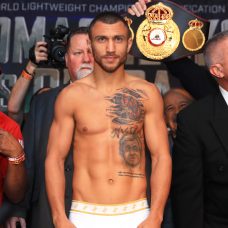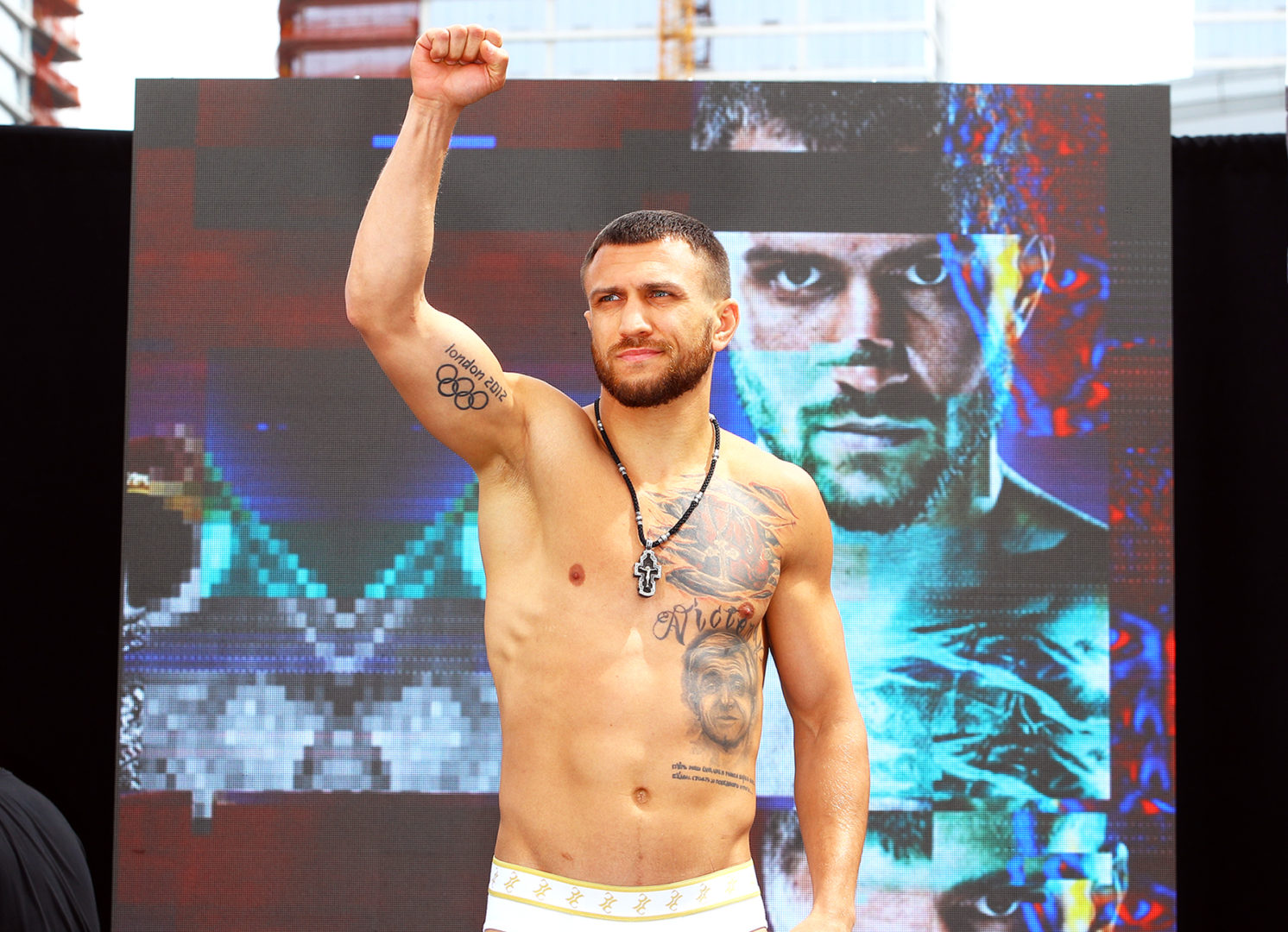By Bart Barry-

Saturday morning (ET) once-defeated Ukrainian lightweight prodigy Vasiliy Lomachenko unconscioused Anthony Crolla before long in Los Angeles. Saturday night undefeated welterweight titlist Terence Crawford will batter and fry Amir Khan in New York. Both men are ESPN champions, both men are former HBO champions, and both men will have to wait at least a week before ESPN’s expert, formerly with HBO, tells us who’s the better man.
Saturday’s was not for Lomachenko a win for the ages, despite what saturation coverage said about it – coverage whose best feature was the hour at which it came. But it was a win that might age OK for what it tells us about the toll such wins take, the necessary suffering that comes with increasing one’s risk baseline till the easiest win exacts some tariff on the winner’s physical self.
For if Anthony Crolla does not represent an easiest win for a fighter that man does not belong in any meaningful conversation about the utterly meaningless pound-for-pound argument promoter Top Rank now goads ESPN to have with itself. The pound-for-pound title was/is on the line this/last week about the way the NBA championship is on the line annually at the Verizon Slam Dunk Contest; if a man might be recognized as prizefighting’s best for icing a thirdtier opponent balletically, why not crown professional basketball’s best player according to one’s talent for balletically dunking on an unguarded net?
As friend and colleague Jimmy Tobin so insightfully tweeted: “Talking about P4P shit is especially silly after a Crolla fight.”
But there they were, 2/3 of the HBO-recycle panel, well into the witching hour Saturday morning, talking about the importance of what Lomachenko did to hapless Anthony Crolla. What he did, apparently, was break his right hand on Crolla’s head, which is meaningful in the same way it was when Floyd Mayweather broke his right hand on Carlos Baldomir’s head in 2006. It mattered naught to the outcome but changed a career’s trajectory.
Never again after Baldomir would Mayweather fight often, cheaply or with a knockout in mind. If Mayweather were never naturally likable, after the Baldomir fight he marketed himself as a villain, sowing his fortune by putting as many pay-per-viewers on the against-side of the ledger as the for-. However well he performed financially Mayweather knew he was nowhere near the fighter he’d been with healthy hands.
And how did Baldomir turn the trick of changing Mayweather’s career? The same way Crolla, and before him Jorge Linares, changed Lomachenko’s career: By simply being a naturally bigger man. Unattributable to talent or fortitude or whatever other euphemism we employ for brutishness, Crolla needed to be struck hard by Lomachenko more times than his lighter predecessors did. Each flush shot Lomachenko felt his knuckles deliver emboldened Lomachenko to sauce even heavier the next.
Thing is, though, there just ain’t that much horsehair or foam or tape between Lomachenko’s knuckles and his victim’s cranium, and there’s but so much density in feathery human handbones and tensile strength in what ligaments keep them ordered at impact, and you can only court the catastrophic so many times before it accepts your proposal. There is no irony in Lomachenko’s having to wait till his right shoulder healed from surgery to generate enough torque to break his right hand; it all speaks to what brittleness age and weight-scaling visit on every prizefighter inevitably if not always proportionately.
Lomachenko knows this. And this knowing begins to explain the urgency with which he has made title fights and climbed weightclasses. In the increasingly entertaining Lomachenko cinema – that precedes his increasingly predictable fights – this time Lomachenko held his breath underwater for three minutes. It was an impressive feat suspensefully rendered. Impressive and suspenseful, that is, until Lomachenko revealed he’d been able to hold his breath 50-percent longer as an amateur.
If Lomachenko is 50-percent less adept at oxygen-denial than he was in his twenties, what else is deteriorated and how much – handspeed, footspeed, reflexes, derring-do? Anthony Crolla sure as hell didn’t tell us.
Until last month, the common wisdom was that Mikey Garcia could. That’s no longer quite so assured. If prizefighters are improved by winning championships they’re diminished by first defeats and especially shutouts. One imagines Garcia returning to lightweight and commencing a reign of terror on whichever taxistas and mecánicos PBC tees-up for him, and perhaps that farce shall endure a bit, but what happens the next time Garcia is across from a man more talented than he is? Does he relentlessly press violence, now confident no lightweight has the power to dent him, or does he 1-2-3 his way to another safe loss?
If Lomachenko-Garcia happens, and there is exactly no reason to think it will, here’s what we’ll tell ourselves: Garcia’s greatest advantage is the fundamentally sound and powerful way of his attack; a jab-cross combo thrown by a powerpuncher at 135 pounds is just the thing to scramble Lomachenko’s signals and reduce the Hi-Tech network from fiberoptic to can-on-a-string.
We’ll do this because as aficionados we’re a bunch adaptive as we are resilient. This week, in fact, we’ll be telling ourselves there’s something quintessentially heroic about Amir Khan’s next knockout loss.
Khan might have taken the easy route by retiring once he was no longer the best in his division but instead he has challenged himself to lose more brutally each year. No, he has not always succeeded in this quest, which proves its nobility. After Danny Garcia detailed him in 2012, Kahn spent two years making rehab matches with retreads who’d not spark him. Then came redemption proper: Khan’s faceplant against Canelo Alvarez won 2016 knockout of the year. Back to the lair went Kahn, effectively retiring in 2017 and 2018 despite fighting twice, before emerging like Zorro for a spectacular loss to Terence Crawford this Saturday.
Crawford, ESPN welterweight champion, and Lomachenko, ESPN lightweight champion, now engage in a pitched hypothetical battle for a still-more hypothetical title: If you take the Lomachenko who just broke his hand punching Crolla and the Crawford who seeks to widow Khan’s wife, and imagine they are the same size, and further imagine their promoter would deign make them fight, who would win Lomachenko-Crawford?
Once you’ve answered that hypothetical question according to the imagined criteria above, forget all of it and ask yourself even dreamier questions like who wows you more and what should the purse-split be for the number of pay-per-view buys you imagine this hypothetical match’d garner. Now take that heaping mess, go to Twitter and find someone who disagrees with you, and engage him relentlessly. Prove yourself a historian or a clairvoyant. Stay engaged.
For whatever you do, don’t refuse to participate in this nonsense till the best men in each division choose to fight one another.
Bart Barry can be reached via Twitter @bartbarry







